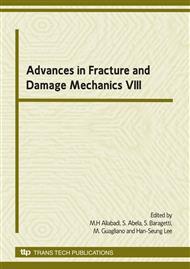p.393
p.397
p.401
p.405
p.409
p.413
p.417
p.421
p.425
Fatigue Strength Evaluation Methods Using Stress Distributions
Abstract:
The stress and displacement fields near the bonding edge, sharp notch, and contact edge show singularity behaviours, so methods of evaluating the strength of these points using maximum stresses calculated by a numerical stress analysis, such as the finite element method, are generally not valid. We have previously presented a new method of evaluating the strength of these singular points using two stress singularity parameters H and λ. In this paper we have developed a method of formularizing critical stress-singularity parameter Hth for each order of stress singularity λ by utilizing critical distance stress theories (point method and line method), which can be derived from two typical strength parameters, namely, fatigue limit σw0 and threshold stress-intensity factor range ΔKth. These estimated critical Hth (λ) value agreed well with the experimentally measured value. Using these simple critical distance stress approach we estimated the fretting-fatigue-crack initiation criteria for any contact edge angle and optimized the contact-edge geometry. Moreover, we apply this new strength criteria to general stress concentration structures.
Info:
Periodical:
Pages:
409-412
Citation:
Online since:
October 2009
Authors:
Price:
Сopyright:
© 2010 Trans Tech Publications Ltd. All Rights Reserved
Share:
Citation:


